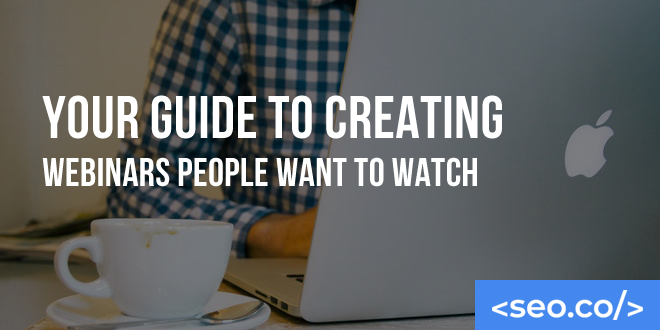Webinars are valuable pieces of interactive content that can give you greater audience engagement and bring more value to your loyal brand fans.
However, the sheer volume of webinars available on any given day is staggering, and if you want to stand out from the crowd, you’ll have to give it a serious effort.
Fortunately, with a bit of hard work and a little practice, it’s possible to create and execute interactive webinars that draw in substantial audiences and keep them engaged with your brand.
Table of Contents
Select a Topic a Relevant & Informative Topic
Selecting a topic is one of the most crucial steps of the process. Finding a subject that can make for a great tagline will ensure that your guest list fills up fast—and that your attendees actually show up for the session.
Key qualities of a great topic
Brainstorming for a topic that hasn’t been done to death can be stressful, but eventually you’ll find a subject that can work as an informational or entertaining session. Before you go any further with fleshing out your idea, make sure your topic has the following qualities:
- Original. Don’t poach someone else’s webinar topic and rephrase it to avoid accusations of plagiarism. Come to the table with something new.
- Straightforward. If your topic can’t be explained to an outsider in the span of one or two sentences, it’s not concise enough to be marketable.
- Valuable. When a potential attendee sees your topic, what are they hoping to get out of it?
Market research and trial runs
Once you’ve begun to flesh out your title, run it by your followers. Pull aside some influencers or vocal fans and ask them what they think—and if they have any ideas that would take the idea to the next level. Gather as much information as possible before moving further.
Perform Research & Gather Data
Now that you have a firm idea about your subject matter, you need to gather enough information on the subject to speak intelligently. Data will be your presentation’s raw material, which you’ll be able to mold into a more compelling form.
Original research
If you can, do some original research (including keyword research for online promotion). Conduct surveys, experiment with real conditions, or put your subject matter to a firsthand test. For example, if you’re giving a webinar about the applications of a new social media strategy, do an A/B test to demonstrate the potential impact of that strategy against a more conventional approach. When you’re on a webinar, people will want to see real facts and statistics that back up your main point.
Take a stance
Nobody wants to watch a webinar that summarizes a high-level view of a given topic. They want a speaker who has a strong opinion about something, one way or another. Using our social media example above, a webinar attendee would much rather see a presentation on why Strategy A is better than Strategy B than a presentation that simply compares the qualities of the two strategies.
Organize Your Research
Now that you have sufficient material, you’ll need to organize it into a coherent presentation—this is easier for some subjects than others.
Tell a story
People are naturally drawn to great stories. If you can find a way to weave a narrative out of your findings, do it. It could be something as simple as an analogy, or a real-life description of events that illustrates the principles you’re trying to drive home. Rather than speculating about applications, give a real application, and keep your users interested by feeding them intricate narratives.
Design
You also need to spend time designing some sort of visual element to your webinar. It doesn’t matter whether you have a slideshow presentation, a video, or some other means of visual display, but you will need something that reflects your brand standards, and something that offers more than a reiteration of bullet points.
Time and practice
Once you have the general outline of your presentation complete, it’s time to start timing and practicing it. Keep your webinar in the one-hour-or-less range, keeping it as concise as possible. If you find yourself frequently going over your allotted time limit, find a way to cut it down. You also need to practice your words enough to speak seamlessly—but not so much that you compromise the naturalness of your voice.
Publicize & Promote Your Upcoming
If you want people to attend your webinar, you have to let them know that it exists. The easiest way to do that is to spread its existence socially.
Social media
Social media is going to be your best friend when spreading the word about your webinar (assuming it’s open to the public). Start sending out save-the-date notifications and regular reminders on an at-least-weekly basis. Get people involved by asking for questions ahead of time, so you can prepare for interactive elements of the presentation.
Invite incentives
If you really want to go all-out, you can offer small incentives to your invitees for sharing the event on their Facebook page, or retweeting information on Twitter. It’s a way to organically acquire brand mentions. It’s a small extra step that could significantly increase your online visibility as well as your eventual attendance rates.
Present the Webinar
The day of the actual webinar, you’ll need to be prepared for a kickass presentation. What you say matters, but how you say it matters more. People will stick around or leave based on how engaging your presentation is, so spend some time perfecting your approach.
Voice and rhythm
Speak at a deliberate pace, avoiding the temptation to speak too quickly or slowly due to nerves, and use natural inflection in your voice—nothing monotonous, but nothing too over-the-top either. Keep a light tone, injecting humor whenever you can, and engage your audience with asides and improvised speech. Don’t rely on overprepared presentation notes to get through.
Questions and answers
It’s also a good idea to host a question-and-answer session after the initial webinar. You can collect audience questions via text and answer them out loud for the public. That level of audience involvement leaves participants with a strong impression, and makes them far more likely to attend future webinars.
Follow-up with Attendees
Once you’ve completed the initial webinar, you’ll have a key opportunity to take advantage of your audience, converting them into leads or attracting them to future webinars.
Download opportunities
First, make sure to provide a download link to the entire webinar for each of your guests. This will give non-attendees the chance to catch up, and will be a nice reward for attendees to take with them. It also shows your commitment to distributing the information to your audience.
Gathering feedback
You also have a great opportunity to improve your future webinars by asking your audience for honest feedback. Chances are, your attendees would love to tell you what they liked and what they felt was missing from your presentation. Take note of this feedback, and use it as a foundation during the creation of your next webinar.
Cultivating leads
You should also file away the names and email addresses of your attendees. When you’re ready to announce your next webinar, send an email blast to all of them, and a portion of your original audience will serve as the groundwork for your next, presumably larger crowd.
Webinars might seem like a lot of work, but they’re worth every hour you pour into them. Keep your audience loyal by continuously asking their opinions, and giving them exactly what they want to see.
Want more information on content marketing, SEO link building or our blog writing services? Head over to our comprehensive guide on content marketing here.
- Your Law Firm SEO Expert: Choosing a Marketing Partner for Your Law Firm - April 10, 2024
- 7 Most Important Keyword Metrics to Track in SEO - April 2, 2024
- Niche Edits: A Guide for Niche Edits in SEO Link Building - February 5, 2024




